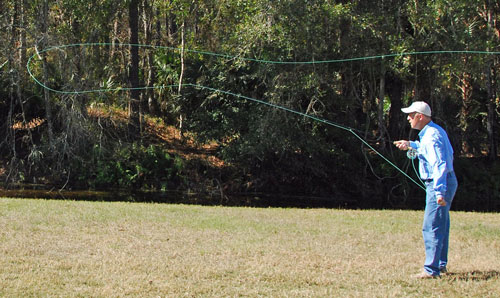The Fly Fishing Double Haul Cast
The double haul is a casting technique I have been using for so long, it is difficult to make a cast without doing it. For fly fishing anglers who only cast short distances, it may be something they never learned to do. For those who fish larger, more open water, or just about any saltwater fly fishing location, the double haul is immensely useful. The hauling technique, is nothing more than a downward tug on the fly line by the non-casting hand. This tug, if done on both the forward and back casts, is a double haul. Hauling can be done on just the forward, just the back, or on both casting strokes.
What does a double haul do and why do I need it?
The act of hauling has two effects on our cast. It increases the bending, or loading, of the rod. It also increases the speed the line is travelling. The result, when done properly, is a cast with a more narrow loop which will travel farther. Both the increased speed and the more aerodynamic loop shape work together to increase distance. This combination is especially effective at hitting long distance targets quickly as well as casting into the wind.
Unfortunately, many anglers try to learn the double haul without having perfected their basic fly casting technique.Very often, I work with students who were hoping to learn the double haul but instead we spend the entire lesson correcting problems with their basic cast. Adding a double haul will rarely overcome poor casting technique. It only adds an additional layer of confusion in many cases. Before attempting the double haul, make sure your foundation is strong.
How to make a double haul fly cast
Before mastering the double haul, I encourage anglers to first use a single haul. The easiest place to make an effective haul is on your delivery stroke. When you are finished false casting and are making your delivery stroke, make a quick downward tug on the line just as you are making our final speed up and stop. Just as you make the stop, you can open the fingers of your line hand, and the line should shoot rapidly through the guides. In order to make the haul, your hands must be close together as you make your back cast. If they are not, you will not have any room to make a downward tug.
Once you are comfortable hauling and shooting line on the delivery stroke, you can try adding a haul to your false cast strokes. The hauling motion is a short downward tug made during the acceleration portion followed by an upward, or recovery motion during the stop and pause. The motion, accelerration, and power from the casting hand remain the same whether hauling or not. That is why it is so important that the stroke with the casting hand must be correct and something you can do without conciously thinking about it.
When the double haul is done correctly, you will see a noticable increase in the speed of the line as it travels back and forth. It will be very tempting to start moving the casting hand faster and with more force but this will only result in over bending the rod causing wide loops. When we combine the double haul with shooting line on both the back and forward false casts, you can achieve distances over 75ft in only a few strokes.

